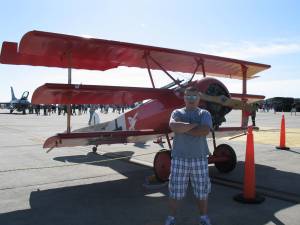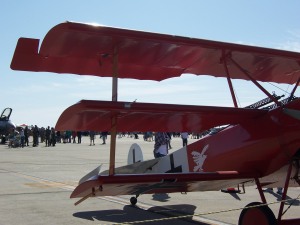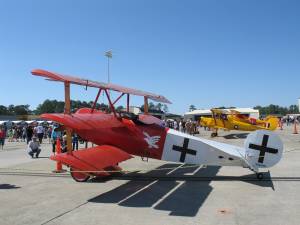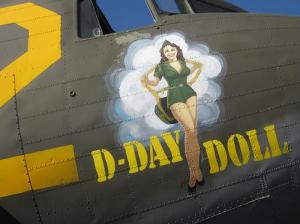Fokker Dr.I
Role Fighter
Manufacturer Fokker-Flugzeugwerke
Designed by Reinhold Platz
First flight 5 July 1917
Primary user Luftstreitkräfte
Number built 320
The Fokker Dr.I Dreidecker (triplane) was a World War I fighter aircraft built by Fokker-Flugzeugwerke. The Dr.I saw widespread service in the spring of 1918. It became renowned as the aircraft in which Manfred von Richthofen gained his last 20 victories, and in which he was killed on 21 April 1918.
Design and development
V.4 prototype
 In February 1917, the Sopwith Triplane began to appear over the Western Front. The Sopwith swiftly proved itself superior to the Albatros fighters then in use by the Luftstreitkräfte. Fokker-Flugzeugwerke responded by converting an unfinished biplane prototype into the V.4, a small, rotary-powered triplane with a steel tube fuselage and thick cantilever wings, first developed during Fokker’s government-mandated collaboration with Hugo Junkers. Initial tests revealed that the V.4 had unacceptably high control forces resulting from the use of unbalanced ailerons and elevators.
In February 1917, the Sopwith Triplane began to appear over the Western Front. The Sopwith swiftly proved itself superior to the Albatros fighters then in use by the Luftstreitkräfte. Fokker-Flugzeugwerke responded by converting an unfinished biplane prototype into the V.4, a small, rotary-powered triplane with a steel tube fuselage and thick cantilever wings, first developed during Fokker’s government-mandated collaboration with Hugo Junkers. Initial tests revealed that the V.4 had unacceptably high control forces resulting from the use of unbalanced ailerons and elevators.
Instead of submitting the V.4 for a type test, Fokker produced a revised prototype designated V.5. The most notable changes were the introduction of horn-balanced ailerons and elevators, as well as longer-span wings. The V.5 also featured interplane struts, which were not necessary from a structural standpoint, but which minimized wing flexing. On 14 July 1917, Idflieg issued an order for 20 pre-production aircraft. The V.5 prototype, serial 101/17, was tested to destruction at Adlershof on 11 August 1917.
Operational history
 Fokker produced two pre-production triplanes, designated F.I, which could be distinguished from production Dr.I aircraft by a slight curve to the tailplane leading edge. These aircraft, serials 102/17 and 103/17, were the only machines to receive the F.I designation. They were sent to Jastas 10 and 11 for combat evaluation, arriving at Markebeeke, Belgium on 28 August 1917.
Fokker produced two pre-production triplanes, designated F.I, which could be distinguished from production Dr.I aircraft by a slight curve to the tailplane leading edge. These aircraft, serials 102/17 and 103/17, were the only machines to receive the F.I designation. They were sent to Jastas 10 and 11 for combat evaluation, arriving at Markebeeke, Belgium on 28 August 1917.
Richthofen first flew 102/17 on 1 September 1917 and shot down two enemy aircraft in the next two days. He reported to the Kogenluft (Kommandierender General der Luftstreitkräfte) that the F.I was superior to the Sopwith Triplane. Richthofen recommended that fighter squadrons be reequipped with the new aircraft as soon as possible. The combat evaluation came to an abrupt conclusion when Oberleutnant Kurt Wolff, Staffelführer of Jasta 11, was shot down in 102/17 on 15 September, and Leutnant Werner Voss, Staffelführer of Jasta 10, was killed in 103/17 on 23 September.
The remaining pre-production aircraft, designated Dr.I, were delivered to Jasta 11. Idflieg issued a production order for 100 triplanes in September, followed by an order for 200 in November. Apart from minor modifications, these aircraft were almost identical to the F.I. The primary distinguishing feature was the addition of wingtip skids, which proved necessary because the aircraft was tricky to land and prone to ground looping. In October, Fokker began delivering the Dr.I to squadrons within Richthofen’s Jagdgeschwader I.
 Compared to the Albatros and Pfalz fighters, the Dr.I offered exceptional maneuverability. Though the ailerons were not very effective, the rudder and elevator controls were light and powerful. Rapid turns, especially to the right, were facilitated by the triplane’s marked directional instability. Vizefeldwebel Franz Hemer of Jasta 6 said, “The triplane was my favorite fighting machine because it had such wonderful flying qualities. I could let myself stunt — looping and rolling — and could avoid an enemy by diving with perfect safety. The triplane had to be given up because although it was very maneuverable, it was no longer fast enough.”
Compared to the Albatros and Pfalz fighters, the Dr.I offered exceptional maneuverability. Though the ailerons were not very effective, the rudder and elevator controls were light and powerful. Rapid turns, especially to the right, were facilitated by the triplane’s marked directional instability. Vizefeldwebel Franz Hemer of Jasta 6 said, “The triplane was my favorite fighting machine because it had such wonderful flying qualities. I could let myself stunt — looping and rolling — and could avoid an enemy by diving with perfect safety. The triplane had to be given up because although it was very maneuverable, it was no longer fast enough.”
As Hemer noted, the Dr.I was considerably slower than contemporary Allied fighters in level flight and in a dive. While initial rate of climb was excellent, performance fell off dramatically at higher altitudes due to the low compression of the Oberursel Ur.II, a clone of the Le Rhône 9J rotary engine. As the war continued, chronic shortages of castor oil made rotary operation increasingly difficult. The poor quality of German ersatz lubricant resulted in many engine failures, particularly during the summer of 1918.
The Dr.I suffered other deficiencies. The pilot’s view was poor during takeoff and landing. The cockpit was cramped and furnished with materials of inferior quality. Furthermore, the proximity of the gun butts to the cockpit, combined with inadequate crash padding, left the pilot vulnerable to serious head injury in the event of a crash landing.
Wing failures
 On 29 October 1917, Leutnant der Reserve Heinrich Gontermann, Staffelführer of Jasta 15, was performing aerobatics when his triplane broke up. Gontermann was fatally injured in the ensuing crash landing. Leutnant der Reserve Günther Pastor of Jasta 11 was killed two days later when his triplane broke up in level flight. Inspection of the wrecked aircraft showed that the wings had been poorly constructed. Examination of other high-time Dr.Is confirmed these findings. On 2 November, Idflieg grounded all remaining triplanes pending an inquiry. Idflieg convened a Sturzkommission (crash commission) which concluded that poor construction and lack of waterproofing had allowed moisture to destroy the wing. This caused the wing ribs to disintegrate and the ailerons to break away in flight.
On 29 October 1917, Leutnant der Reserve Heinrich Gontermann, Staffelführer of Jasta 15, was performing aerobatics when his triplane broke up. Gontermann was fatally injured in the ensuing crash landing. Leutnant der Reserve Günther Pastor of Jasta 11 was killed two days later when his triplane broke up in level flight. Inspection of the wrecked aircraft showed that the wings had been poorly constructed. Examination of other high-time Dr.Is confirmed these findings. On 2 November, Idflieg grounded all remaining triplanes pending an inquiry. Idflieg convened a Sturzkommission (crash commission) which concluded that poor construction and lack of waterproofing had allowed moisture to destroy the wing. This caused the wing ribs to disintegrate and the ailerons to break away in flight.
In response to the crash investigation, Fokker improved quality control on the production line, particularly varnishing of the wing spars and ribs, to combat moisture. Fokker also strengthened the rib structures and the attachment of the auxiliary spars to the ribs. Existing triplanes were repaired and modified at Fokker’s expense.[22] After testing a modified wing at Adlershof, Idflieg authorized the triplane’s return to service on 28 November 1917. Production resumed in early December. By January 1918, Jastas 6 and 11 were fully equipped with the triplane. Only 14 squadrons used the Dr.I as their primary equipment. Most of these units were part of Jagdgeschwadern I, II, or III. Frontline inventory peaked in late April 1918, with 171 aircraft in service on the Western Front.
Despite corrective measures, the Dr.I continued to suffer from wing failures. On 3 February 1918, Leutnant Hans Joachim Wolff of Jasta 11 successfully landed after suffering a failure of the upper wing leading edge and ribs. On 18 March 1918, Lothar von Richthofen, Staffelführer of Jasta 11, suffered a failure of the upper wing leading edge during combat with Sopwith Camels of No. 73 Squadron and Bristol F.2Bs of No. 62 Squadron. Richthofen was seriously injured in the ensuing crash landing.
Postwar research revealed that poor workmanship was not the only cause of the triplane’s structural failures. In 1929, National Advisory Committee for Aeronautics (NACA) investigations found that the upper wing carried a higher lift coefficient than the lower wing — at high speeds it could be 2.55 times as much.
The triplane’s chronic structural problems destroyed any prospect of large-scale orders. Production eventually ended in May 1918, by which time only 320 had been manufactured.[28] The Dr.I was withdrawn from frontline service as the Fokker D.VII entered widespread service in June and July. Jasta 19 was the last squadron to be fully equipped with the Dr.I.[29]
Surviving triplanes were distributed to training and home defense units. Several training aircraft were reengined with the 75 kW (100 hp) Goebel Goe.II. At the time of the Armistice, many remaining triplanes were assigned to fighter training schools at Nivelles, Belgium, and Valenciennes, France. Allied pilots tested several of these triplanes and found their handling qualities to be impressive.
Postwar
Very few triplanes survived the Armistice. Serial 528/17 was retained as a testbed by the Deutschen Versuchsanstalt für Luftfahrt (German Aviation Research Institute) at Adlershof. After being used in the filming of two movies, 528/17 is believed to have crashed sometime in the late 1930s.[32] Serial 152/17, in which Manfred von Richthofen obtained three victories, was displayed at the Zeughaus museum in Berlin. The triplane was destroyed by an Allied bombing raid during World War II. Today, only a few original Dr.I artifacts survive in museums.
Replica aircraft
 While no Dr.I airframes survive, large numbers of flying and static replicas have been built. In 1932, Fokker built a Dr.I from the spare parts of various aircraft. The reproduction appeared in the 1939 film D III 88. Bitz Flugzeugbau GmbH built two Dr.I replicas for use in Twentieth Century Fox’s 1966 film The Blue Max. One of these aircraft currently operates in the United States.
While no Dr.I airframes survive, large numbers of flying and static replicas have been built. In 1932, Fokker built a Dr.I from the spare parts of various aircraft. The reproduction appeared in the 1939 film D III 88. Bitz Flugzeugbau GmbH built two Dr.I replicas for use in Twentieth Century Fox’s 1966 film The Blue Max. One of these aircraft currently operates in the United States.
Since April 1994, the National Museum of the United States Air Force at Wright-Patterson Air Force Base has displayed a reproduction Fokker Dr. I. It is painted in the markings of a Jagdstaffel 19 aircraft flown by Leutnant Arthur Rahn in April 1918.
Large numbers of replica aircraft have been built for both individuals and museums. Due to the expense and scarcity of authentic rotary engines, most airworthy replicas are powered by a Warner Scarab or Continental R-670 radial engine. A few, however, feature vintage Le Rhône 9 or reproduction Oberursel Ur.II rotary engines.
* V.3 – Initial prototype
* V.4 – First production prototype
* V.5 – Prototype with Goebel Goe.III engine
* V.6 – Enlarged prototype with Mercedes D.II engine
* V.7 – Prototype with Siemens-Halske Sh.III engine
* V.10 – Prototype with Oberursel Ur.III engine
Operators
German Empire
* Luftstreitkräfte
Specifications (Dr.I)
General characteristics
 * Crew: One
* Crew: One
* Length: 5.77 m (18 ft 11 in)
* Wingspan: 7.20 m (23 ft 7 in)
* Height: 2.95 m (9 ft 8 in)
* Wing area: 18.70 m² (201 ft²)
* Empty weight: 406 kg (895 lb)
* Loaded weight: 586 kg (1,292 lb)
* Powerplant: 1× Oberursel Ur.II 9-cylinder rotary engine, 82 kW (110 hp)
* Zero-lift drag coefficient: 0.0323
* Drag area: 0.62 m² (6.69 ft²)
* Aspect ratio: 4.04
Performance
* Maximum speed: 185 km/h at sea level (115 mph at sea level)
* Stall speed: 72 km/h (45 mph)
* Range: 300 km (185 mi)
* Service ceiling: 6,095 m (20,000 ft)
* Rate of climb: 5.7 m/s (1,130 ft/min)
* Lift-to-drag ratio: 8.0
Armament
* 2 × 7.92 mm (.312 in) “Spandau” lMG 08 machine guns.








